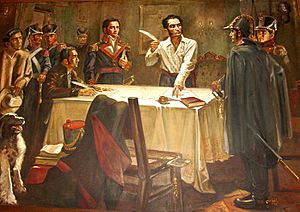Decree of War to the Death facts for kids

The Decree of War to the Death, known in Spanish as Decreto de Guerra a Muerte, was a special order given by the South American leader Simón Bolívar. This decree allowed very harsh actions against people born in Spain, unless they were actively helping South America become independent. It also forgave people from the Americas who had already taken such actions. The phrase "war to the death" was a way to describe these very tough actions.
Bolívar issued this decree to help Venezuela win its independence from Spain. He felt that the Spanish Army had used very harsh methods against those who supported the First Republic of Venezuela. He believed these actions had led to the defeat of the First Republic.
Simón Bolívar announced this decree on June 15, 1813, in the Venezuelan city of Trujillo.
Contents
Why the Decree Was Made
The decree stated it was a response to serious crimes and violent acts by Spanish soldiers. This happened after the First Republic fell. The decree claimed that Spanish leaders had stolen property and killed many people who supported the Republic. It said: "we could not just watch the suffering caused by the harsh Spaniards, who have robbed and killed you, and broken important agreements." It also claimed they had "committed every crime, leaving the Republic of Venezuela in terrible ruin."
The decree announced that all people born in Spain who did not actively support independence would be killed. However, all South Americans would be spared, even if they had worked with the Spanish authorities. A main goal of the document was to assure important Venezuelans that they would not be punished for having worked with the Spanish. The decree was the first step in changing how the war was seen. It went from being just a rebellion in one of Spain's colonies to a full war between two different countries: Venezuela and Spain.
How the "Guerra a Muerte" Was Carried Out
This "War to the Death" policy was used by both sides. It led to some very harsh actions. For example, Spanish prisoners were killed in Caracas and La Guaira in February 1814. This happened on orders from Bolívar himself, just before the Second Republic of Venezuela collapsed. Also, several well-known citizens in New Granada were killed by the royalist army in 1815, 1816, and 1817.
The decree stayed in effect until November 26, 1820. On that date, General Pablo Morillo met with Bolívar at Santa Ana de Trujillo. They agreed to make the war of independence a regular war, following common rules.
Main Points of the Decree
The decree stated that an army from New Granada had come to free Venezuelans. It said their mission was to remove the Spanish and bring back the republican governments of Venezuela.
It also said that the leaders could not ignore the suffering caused by the Spanish. It called for justice and punishment for those who had caused harm.
However, the decree also offered a chance for peace. It invited Spaniards to live peacefully if they helped destroy the Spanish government and bring back the Republic of Venezuela.
The decree warned that any Spaniard who did not actively work for independence would be seen as an enemy and punished. But, any Spaniard who joined the independence army or helped the cause would be forgiven and treated like an American.
To the Americans who had supported the Spanish, the decree offered forgiveness. It said that their brothers understood they were not truly guilty. It promised them safety for their honor, lives, and property. The decree stated that being an American would protect them.
This forgiveness even extended to those who had recently acted against the cause. The decree promised that this offer would be kept, no matter what.
In summary, the decree told Spaniards and people from the Canary Islands to expect death if they did not actively support America's independence. But it told Americans to expect life, even if they had been on the other side.
See also
 In Spanish: Decreto de Guerra a Muerte para niños
In Spanish: Decreto de Guerra a Muerte para niños
- Shoot on the Spot Declaration

